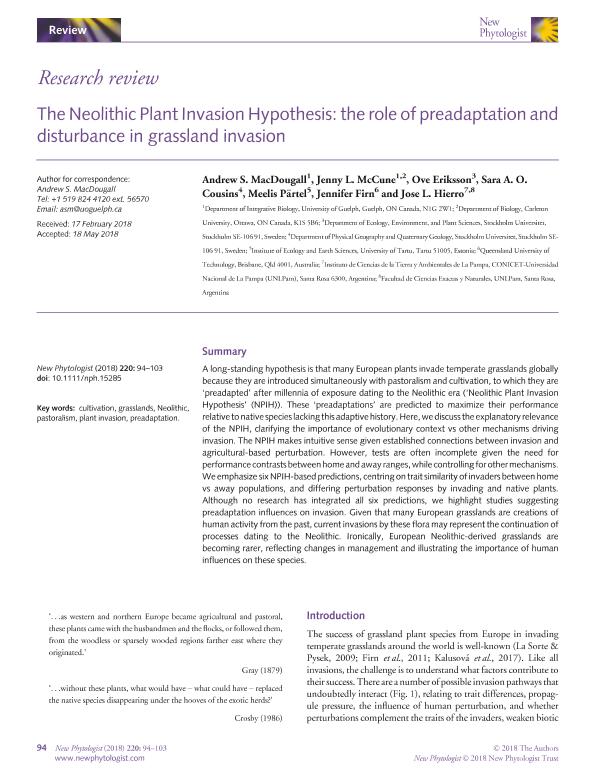Artículo
The Neolithic Plant Invasion Hypothesis: the role of preadaptation and disturbance in grassland invasion
MacDougall, Andrew S.; McCune, Jenny L.; Eriksson, Ove; Cousins, Sara A. O.; Pärtel, Meelis; Firn, Jennifer; Hierro, Jose Luis

Fecha de publicación:
10/2018
Editorial:
Wiley Blackwell Publishing, Inc
Revista:
New Phytologist
ISSN:
0028-646X
Idioma:
Inglés
Tipo de recurso:
Artículo publicado
Clasificación temática:
Resumen
A long-standing hypothesis is that many European plants invade temperate grasslands globally because they are introduced simultaneously with pastoralism and cultivation, to which they are ‘preadapted’ after millennia of exposure dating to the Neolithic era (‘Neolithic Plant Invasion Hypothesis’ (NPIH)). These ‘preadaptations’ are predicted to maximize their performance relative to native species lacking this adaptive history. Here, we discuss the explanatory relevance of the NPIH, clarifying the importance of evolutionary context vs other mechanisms driving invasion. The NPIH makes intuitive sense given established connections between invasion and agricultural-based perturbation. However, tests are often incomplete given the need for performance contrasts between home and away ranges, while controlling for other mechanisms. We emphasize six NPIH-based predictions, centring on trait similarity of invaders between home vs away populations, and differing perturbation responses by invading and native plants. Although no research has integrated all six predictions, we highlight studies suggesting preadaptation influences on invasion. Given that many European grasslands are creations of human activity from the past, current invasions by these flora may represent the continuation of processes dating to the Neolithic. Ironically, European Neolithic-derived grasslands are becoming rarer, reflecting changes in management and illustrating the importance of human influences on these species.
Palabras clave:
Cultivation
,
Grasslands
,
Neolithic
,
Pastoralism
,
Plant Invasion
,
Preadaptation
Archivos asociados
Licencia
Identificadores
Colecciones
Articulos(INCITAP)
Articulos de INST.D/CS D/L/TIERRA Y AMBIENTALES D/L/PAMPA
Articulos de INST.D/CS D/L/TIERRA Y AMBIENTALES D/L/PAMPA
Citación
MacDougall, Andrew S.; McCune, Jenny L.; Eriksson, Ove; Cousins, Sara A. O.; Pärtel, Meelis; et al.; The Neolithic Plant Invasion Hypothesis: the role of preadaptation and disturbance in grassland invasion; Wiley Blackwell Publishing, Inc; New Phytologist; 220; 1; 10-2018; 94-103
Compartir
Altmétricas



